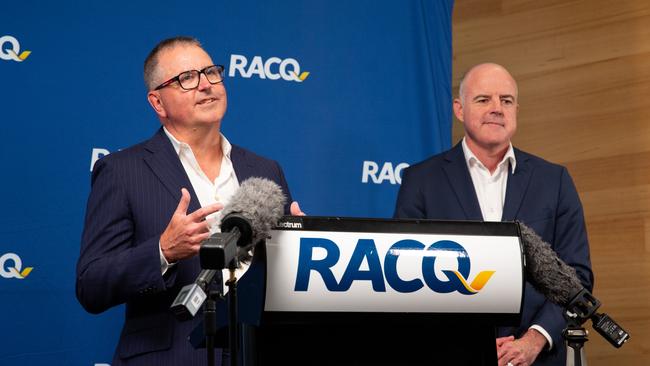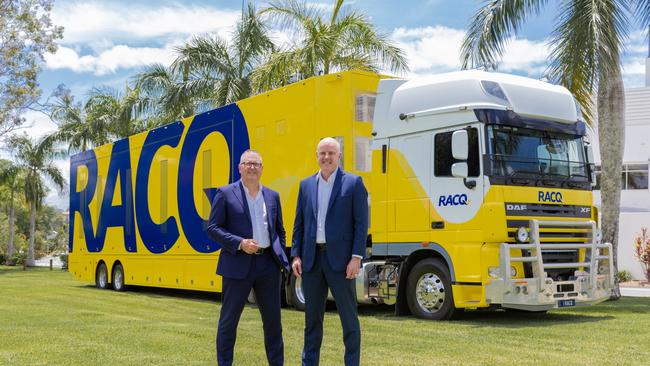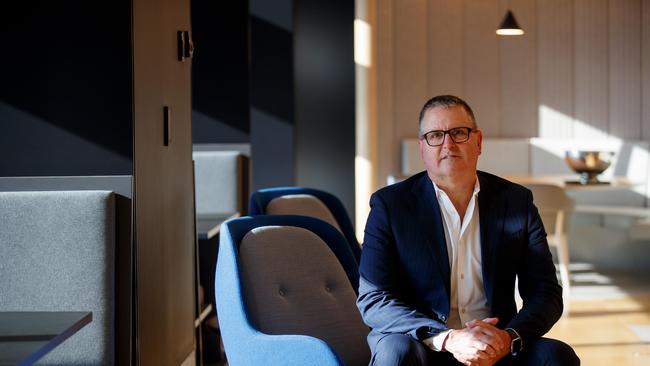IAG charts growth story as AI-powered insurance revs up
ASX-listed insurer IAG, operator of RACV and NRMA, is debating whether to bank or reinvest the millions it expects to save from new AI-powered technologies being introduced.

Business
Don't miss out on the headlines from Business. Followed categories will be added to My News.
Insurance Australia Group is mulling whether to bank or reinvest the millions it expects to save from new AI-powered technologies being rolled out across its divisions, and its plans to capitalise on the country’s immigration spurt are central to the listed insurer’s growth story.
In an investor day update on Tuesday, IAG, which operates insurance brands including NRMA, RACV, CGU, WFI and soon RACQ, revealed its progress in consolidating its disparate platforms and systems.
IAG chief executive and managing director Nick Hawkins said the insurer was looking at a growing population, expected to climb by almost two million by 2030, which would add to demand. This was coupled with cars and homes it insured steadily climbing in cost to replace or repair as their value rose “faster than GDP”.
Mr Hawkins, who took on the top job at IAG in November 2020, is attempting to expand the insurer’s base by almost a million extra customers, on top of the nearly 1.7 million RACQ members added in a recent deal.
IAG revealed last week it had struck a $8.55m deal to buy the underwriting arm of Queensland motoring mutual RACQ. This will add almost $1.3bn in gross written premium to IAG, which boasts a presence on the nation’s roads through its NRMA, Rollin’ and RACV brands.
Mr Hawkins said customer growth was picking up again after tough conditions as many Australians faced down inflation but IAG was “not walking away” from its growth targets.

A key plank of IAG’s growth plans centres on attempts to recruit members of the burgeoning Indian and subcontinental migrant community following the success of a recent campaign appealing to Chinese migrants.
But on Tuesday IAG touted a string of new AI-powered platforms rolled out in the past year, with the insurer hopeful many would slash costs to underwrite or manage claims.
IAG also revealed its efforts to use 3D printing to repair or replace car parts.
Mr Hawkins told The Australian IAG had an opportunity to improve the way it was communicating with customers around timelines and claims handling.
“Often we make that unnecessarily complex for customers,” he said.
He said a key issue previously had been resourcing in the event of disasters. But he said IAG had “done a lot” to resolve disputes and complaints.
Mr Hawkins said cars were becoming more complex and more expensive to insure and repair.
IAG chief operating officer Neil Morgan said the insurer had been lucky many AI technologies had surfaced in recent years soon after it had completed its project to replace several claims management systems with one core platform. IAG had been undertaking “back-to-back transformations since 2018”, with 289 assets decommissioned.
Mr Morgan said the insurer was now seeing “material improvement” in its risk selection and pricing accuracy”.
However, this comes too late for IAG to avoid court action by the Australian Securities & Investments Commission, which is suing the insurer over years of pricing failures where customers did not receive discounts they were promised.

IAG has rolled out GENI, an AI-bot builder, alongside CASI, an AI-powered claims manager. These systems and IAG’s plans to consolidate its remaining retail pricing and intermediated platforms are expected to lead to a slump in the cost to handle claims or price policies.
IAG executive general manager claims Tim Rafton said the new systems were allowing IAG to slash the amount of outstanding claims by almost 30 per cent.
Mr Rafton said the insurer was now faced with the “conscious decision” whether to set about “banking some of that benefit at the right point or reinvesting it into other things, around service propositioning”.
NRMA insurance boss Julie Batch said insurance switching by price-conscious customers was still going strong but levels were slowing as price rises were tempered and “normal conditions” were returning to the car repair market after an explosion in costs during the Covid-19 pandemic.
Restating its guidance for the year ahead, IAG assured investors it was on track to deliver gross written premium growth in the “mid-to-high single digit”.
Shares in IAG closed up 0.24 per cent to $8.53, lifting 2c.
More Coverage
Originally published as IAG charts growth story as AI-powered insurance revs up





